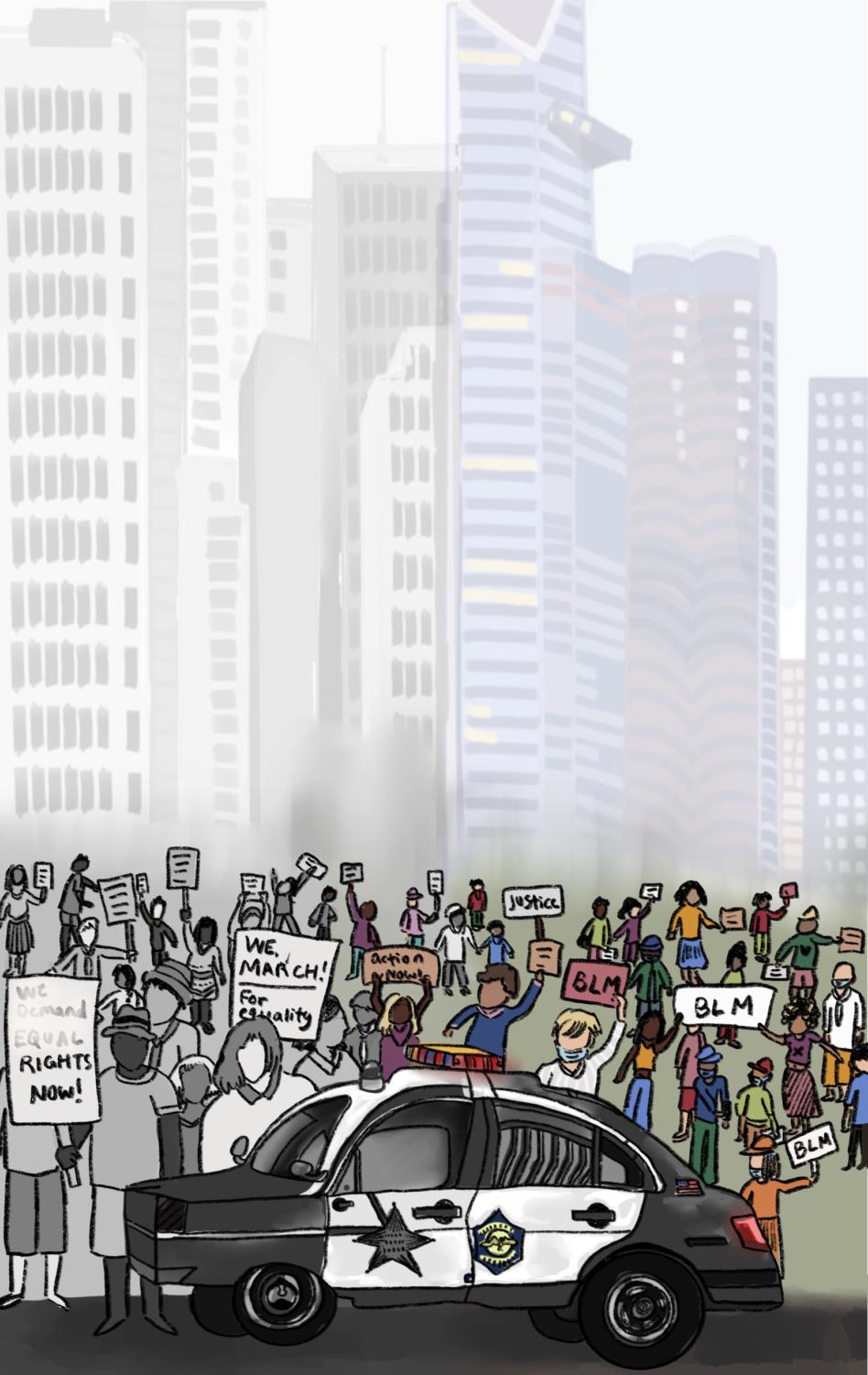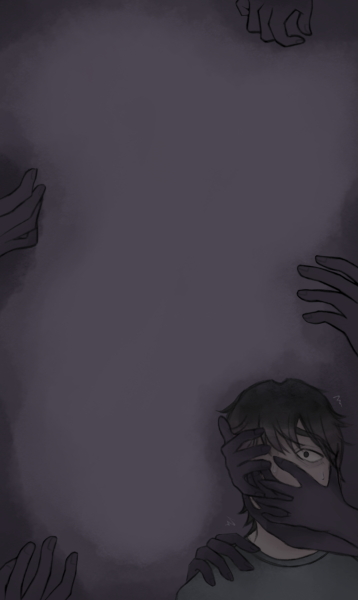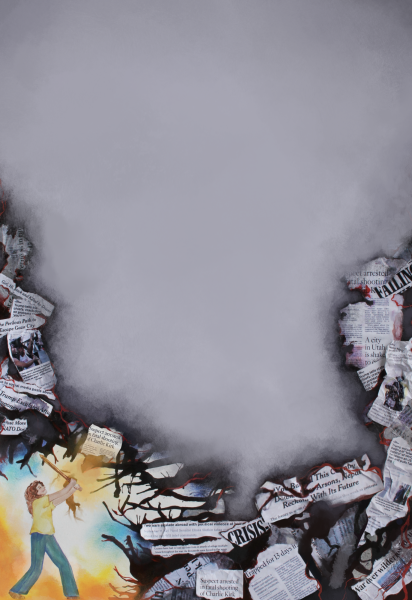Seeing in Color: Acknowledging our Past

A group of Poway Unified parents gathered at the June 3 school board meeting protesting what parent Sterling Moffet called “a new curriculum whose implementation will serve to divide students on racial lines.”
“This curriculum is taking the bad parts of our history and not balancing it out with the good parts,” parent Karin de Jauregui said. “It’s overcorrecting and now, in fact, it is marginalizing white students.”
This upheaval surrounded critical race theory (CRT) and its teaching at PUSD schools.
Critical race theory is a hot button issue. It
entered the cultural zeitgeist with controversy between the implementation 1619 project vs 1776 commission last year and has led to overall discourse about its implementation in education.
This discourse serves as another dividing line between political parties with left leaning voters siding more for CRT and right leaning voters siding against it.
Black Student Union president Ekene Okolo (12) works to bring students together and understand systemic racism and CRT can bring us together.
“Critical race theory states that race affects every aspect of our society, and that the influence of race and racism is present in micro and macro levels,” Okolo said. “People believe it’s indoctrination, teaching students to hate their white counterparts, meant to villainize their racial group. In fact, it’s really working to reach the opposite: a more united and equal student body.”
According to Okolo, CRT isn’t trying to create a new narrative on racism’s effects. Instead, it explains the parts of history that have not been taught before.
“For a long time, we haven’t really been getting an education that tells us the full scope of how race relations came to be in America,” Okolo said. “As we all know, history is told by the victors, and I feel like people who have been marginalized haven’t been able to tell their side of the story. Critical race theory works towards bridging that gap, allowing the entire story to be told.”
The misinformation spread about CRT and its points have created strong opposition to the movement, with it being classified as divisive and marxist in nature.
“There’s too much talk of white privilege, white supremacy, and it’s not fair to teach that to innocent kids,” De Jarguei said. “They are teaching kids that they are either oppressed or the oppressor.”
However, Okolo believes CRT has the opposite effect on students when given more time to process the information, it’s really just people who have a surface level understanding of what the theory tries to say that create opposition
“I think people hear critical race theory and instantly turn their ears off,” Okolo said. “This is probably because of all the negative connotations race, racism and CRT itself bear. Even citing CRT automatically closes them off to the idea of learning more about systemic racism entirely. Personally, I think CRT is crucial to be implemented. Or, at least if it’s not a full CRT curriculum, it could be implemented in the form of ethnic studies, ethnic literature or any other course that serves to teach about race in America.”
San Diego State University Ethnic Studies professor Michael Domíguez said CRT is used at the collegiate-level to explain disparities in racial equality.
“CRT is an analytical toolkit that gives us a framework to be able to talk about and make sense of how racism emerges, so that we can have meaningful conversations about it,” Domínguez said. “In scholarship, we look at the world using different analytical frameworks to make sense of things. It’s almost like using different lenses to shape and change an image when taking a picture. It allows us to work towards common goals even if we have different presuppositions and definitions.”
Critical race theory stems from critical legal studies, which were used to examine how laws and policies can perpetuate inequality. CRT founder Derrick Bell constructed it when looking for an explanation for why racism persists even after the civil rights movement and how it was continually perpetrated through US history.
The idea of how this discrimination is historical yet ongoing is pivotal to CRT discourse, describing how racism has been a constant presence throughout U.S. history.
“Patterns of racial bias transform, shift and carry across institutions and behaviors regardless of individual intention,” Domínguez said. “They get baked into these institutions and the racist intentions that weighed on them in the past essentially carry through and linger today.”
President of Awareness for Change and history buff Aiken Wang (11) has thoroughly studied the ways this racism has carried through to this day and continues to perpetrate inhuman actions after feeling he wasn’t given a full understanding of such topics in his education.
Through his extensive research Wang was able to find out a lot he didn’t know about the persistence of racism in our country especially against Asian Americans.
Bell states in his essay Race Realism that this ability to create legal disparities stems from underlying white supremacy. Not the white supremacy of the Ku Klux Klan and Proud Boys, but the idea that being white allows you to gain certain advantages in life that others can never obtain, and thus contribute to racist systems.
This idea of white supremacy is the point that converts many into vehement opponents of the movement. A surface-level interpretation may lead some to believe that it is accusing them of perpetuating racism.
“Essentially, [CRT is] saying if you’re a straight white American, you’re guilty of being a racist, ’’ Fox news anchor Tucker Carlson said in his July sixth segment of Tucker Carlson daily. “It’s your fault. You’re a bad person.”
Domínguez said the agitation of being called a racist, due to the stigma of the word, can cause people severe adverse reactions and is most likely the root of people’s alarm.
“This fear is actually a neurological process called an abreaction,” Domínguez said. “Essentially, it is a psychological way in which we react to things that are threats to our sense of self when we get told things that destabilize our sense of who we are, sense of our place in the world.”
Domínguez said this has been the case ever since the end of the civil rights movement.
“Since the 1970s, there has been this sort of vision that we’ve been told by people in power,” Domínguez said. “It’s this viewpoint that we’ve passed the Civil Rights Act, and have therefore ended systemic racism altogether. This was wrapped up in broader politics and policies of trying to actually roll back some of the protections gained during the civil rights movement, such as protection of voting rights.”
Wang points out some of these specific systems that continued to penetrate racism following the Civil Rights Act that he was not taught in school.
“By the 1960s desegregation was put in place and now African Americans can vote. However, they’re still poor due to a lack of a way to grow generational wealth. Furthermore, the government still has policies like redlining so it’s still very hard for you to get loans. All this discrimination leads to a wealth gap and segregation as a side effect, even if it’s not legally sanctioned this time.”
Stanford Associate Professor of Graduate Education Subini Annamma studies how we are taught and affected by systemic racism in the classroom.
Annamma said even after the desegregation of schools following the Brown v. Board of Education decision in 1954, segregation was still prominent in the U.S. school system.
“Even through the ’70s, people were fighting the lawsuit and schools were still being integrated into the late stages of that decade,” Annamma said. “So when your parents probably were going to school, schools were still legally segregated.”
Annamma’s studies are built on the idea that systemic racism still exists in education.
“Nationally, Black girls are suspended at five to six times the rate of white girls, according to the Civil Rights Data Collection,” she said. “This is without any higher correlation with worse behaviors in these students. Teachers, staff at school, or the adults at school, punish Black girls more often for behaviors that they don’t suspend white girls for.”
To Annamma it is obvious that there are still inequalities present due to race all around us. These are things she believes we can counteract through education of racial inequality today and throughout history.
“The question shouldn’t be whether or not CRT should be taught, but why is it not being taught in schools, because that’s not really the point that the people who are opposed to CRT being taught in schools are getting at,” Annamma said. “In reality, they are just using CRT as a cover for any conversations about race, and they don’t think any conversations about racism should be taught in schools. Because to them, racism is just one person being mean to another person. They lack the understanding of racism at the systemic level and how it’s built into society.”
Wang agrees with this need to overcome the hesitancies we find in race so we can be able to understand and build up our country in the future.
“I think being cognizant of our issues is more important than telling ourselves how great we are as a country,” Wang said. “If a student looks at all the hundreds he got and ignores all his failures, he’s probably not going to improve very much and as an American I want to improve my country to the best of my ability.”
Domínguez said The stigma of the word “racist” has affected conversations about its presence to this day. If Americans are unable to bring ourselves to accept that they are members of these systems, then moving forward in the conversations about racism will be impossible.
“Because we’ve been trained to not talk about race [and to] not make sense of our own racial identity, then when that comes up, it hits that abreaction,” Domínguez said.
He said in order to overcome this barrier there needs to be a more nuanced understanding of what is meant when white supremacy is used to explain racism’s persistence and how that fits into the idea of CRT as a whole.
This nuance about CRT is something social science teacher Andrea Champoux is also teaching in her Ethnic Studies course at Westview.
“In class, I try to introduce it to the students: what it is, what people are saying for it and what people are saying against it,” Champoux said. “I’m really providing them with the facts of the matter for them to build their own understanding of what it is and how it kind of impacts us as a class in general.”
Champoux said she is able to dive deep into this subject, and the teaching she provides in the classroom has yet to stir controversy among her own students. She said they are all able to understand the concepts and grasp the ways in which racism works in American society.
Champoux also said she sees first hand how a lack of understanding of racism can affect students’ outlooks on life.
“It’s clear that some of my U.S. History students don’t believe that racism still exists in society,” she said. “They’re like, ’Oh, that was taken care of in the civil rights movement,’ because they just know that single story, or that master narrative of it, and don’t understand that it is still prevalent within the U.S.”
This idea of a historically taught master narrative is what Ethnic Studies works to counteract, instead of teaching a counter-narrative to what we’ve been told.
“There’s a lot of things that have failed to be mentioned in the textbook that we have been using in this class,” Champoux said. “The whole idea of critical race theory is just to simply be aware that we have implicit bias and [to] be aware of the racism that does exist. Whether someone means to be racist or not, it’s the simple awareness and education of it that I think will advance society together to be more empathetic and open to others.”
Annamma said it is important for these concepts to be taught in schools, and teaching these concepts to students will brighten the future in combating racism.
“We really should never deny the opportunity for CRT, or any tool of analysis that helps us understand racism better in education, because that gives us a tool to dismantle it,” Annamma said. “So a lot of what is being argued is this: Learning about this history makes white children feel bad. And my continual response to that is, why would it make white children feel bad? It gives them an opportunity, a tool–critical race theory empowers white children, just like it empowers black and brown children. Critical race theory is one tool that can empower all of us to better understand how racism is built into institutions and systems. Once we understand that, together we can work to dismantle the racist power structures that create racial inequities in society .”






